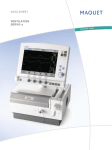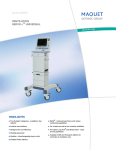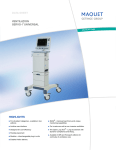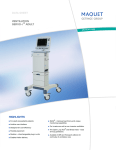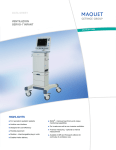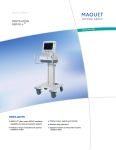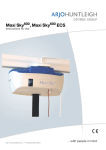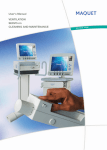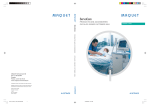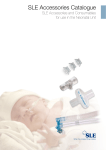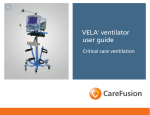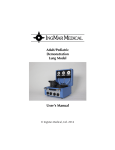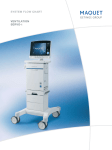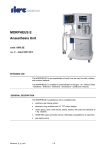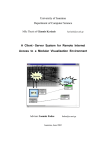Download VENTILATION SERVO-i INFANT DATA SHEET
Transcript
DATA SHEET VENTILATION SERVO-i INFANT | The Gold Standard | Critical Care | SERVO-i Infant | 3 | SERVO-i INFANT – SENSITIVE VENTILATION OF NEONATAL AND PEDIATRIC PATIENTS MAQUET – THE GOLD STANDARD Leading the way: MAQUET is a premier international provider of medical technology solutions. Focused on the OR and ICU, the company is committed to developing solutions that improve patient care. MAQUET draws on many years’ experience in supplying state-of-the-art ventilator systems. Since the introduction of the first SERVO ventilator in 1971, SERVO has become the world’s number one ventilation brand. SERVO-i now sets the standard for critical care ventilation. It delivers the highest level of clinical performance to help clinicians provide the best possible care for neonatal, pediatric and adult patients. SERVO-i is also very simple to learn and use. Designed to be easily upgradeable, it grows with the hospital’s changing needs to ensure lasting value. SERVO-i Infant: Sensitive ventilation of neonatal and pediatric patients MAQUET – The Gold Standard. | 4 | SERVO-i Infant | Critical Care | HIGHLIGHT S SERVO-i INFANT For neonatal to pediatric patients Standard ventilation modes: Controlled ventilation: – Pressure Control (PC) Y sensor measuring of flow and pressure for measurements closer to the patient’s airways Supports invasive ventilation as well as non invasive ventilation with leakage compensation Supported ventilation: – Pressure Support (PS)/CPAP Combined ventilation: – SIMV (PC) + PS Optional ventilation modes: Controlled ventilation: – Volume Control (VC) – Pressure Regulated Volume Control (PRVC) Supported ventilation: – Volume Support (VS) Combined ventilation: – SIMV (VC) + PS (included in the VC option) – SIMV (PRVC) + PS (included in the PRVC option) – Bi-Vent Non invasive modes: Optional functions: – Automode® (Pressure/Volume/PRVC) – Upgrade to SERVO-i Universal all patient categories (Adult & Infant) – Nebulizer – Open Lung Tool® – Y sensor measuring – CO2 analyzer – Alarm output connector for external alarm A platform for the future – choose the level of system and application you need for today; add further functionalities for tomorrow Flexible placement – easy positioning, either on a SERVO-i Mobile Cart, or on a SERVO-i Holder or a SERVO-i Shelf Base for bed/shelf/wall mount Uninterrupted bedside quality ventilatory treatment during transportation of ICU patients Designed for cost-efficiency: – Easy training, operation and maintenance – Fast, simple start-up procedures with user configured preset ventilator settings – One-piece interchangeable part for cleaning – Extended maintenance intervals – Quick access to previous ventilation mode settings – Nasal CPAP – Non Invasive Ventilation (NIV) Pressure Support – Non Invasive Ventilation (NIV) Pressure Control Simple user interface: – Selectable between touch screen, knobs or dial – Direct access knobs for vital settings – Menues with only two main levels Non-consumable and maintenance-free ultrasonic O2 sensor optional to consumable O2 cell Modular – a common base ventilator with your choice of functionalities and convenient interchangeable plugin units – battery modules, CO2 module and Y sensor module | Critical Care | SERVO-i Infant | 5 | GENERAL INFORMATION SERVO-i INFANT SERVO-i ® Infant supports neonatal and pediatric patients through multiple ventilation modes and sensitive triggering responses. With its compact design, advanced functionality and ease of use SERVO-i Infant is well suited for virtually all infant ventilation needs in the Intensive Care Unit and for patient transportation within the hospital. SERVO-i is also highly suited for interhospital transport of ICU patients with its long battery operating time and optimized gas consumption*. Compact and flexible design makes it easy to position the equipment as desired for best access and convenient operation. The patient unit can be turned for patient connection from the left or right side. The user interface can be turned and tilted for convenient handling and overview. The ‘Lift Out’ capabilities – using the SERVO-i Mobile Cart, the SERVO-i Holder and/or the SERVO-i Shelf Base – increase flexibility and facilitate patient transportation with no loss of treatment values. The SERVO-i Holder and the user interface can be placed on a wall, a shelf or on the bed. * Interhospital transport use of SERVO-i requires a formal agreement with MAQUET. The SERVO-i patient unit and user interface can easily be removed from the Mobile Cart ... ... and positioned on the SERVO-i Holder for bedside placement flexibility. | 6 | SERVO-i Infant | Critical Care | GENERAL INFORMATION SERVO-i INFANT The Nasal CPAP mode provides nasal CPAP ventilation for the smallest patients. Combined with nasal prongs or nasal masks it delivers a constant airway pressure to the patient. The Pressure Support ventilation mode reduces the work of breathing and responds instantly to the child’s changing needs. Preset ranges for relevant parameters are automatically set, even when changing from one mode to another. Preferred treatment parameters can be safely and flexibly customized. With Y Sensor Measuring it is possible to measure flow and pressure as close as possible to the patient’s airway. The sensor connected to the Y-piece presents accurate measurements on the user interface. SERVO-i supports both invasive ventilation and Non Invasive Ventilation (NIV). SERVO-i supports invasive ventilation and also Non Invasive Ventilation (NIV) with an effective leakage compensation, thus maintaining the pressure set to the patient. NIV supports ventilation in the Pressure Control and Pressure Support modes. In the case of apnea, a ventilator controlled breathing frequency is automatically activated to maintain desired ventilation. SERVO-i Infant offers a wide range of ventilation modes and tools with sensitive triggering responses to meet a variety of upcoming ventilation needs. Modes well suited for infant ventilation come as standard with the ventilator. For future needs more modes and functions can easily be added by means of a PC card. The user can configure the ventilator to start up exactly the way he wants. The default ventilation mode as well as all the corresponding default ventilation parameters can be set by the user. The Automode ® option allows complete, automatic patient interaction for shorter weaning times, less staff intervention and better patient comfort with less sedation. A back-up apnea function ensures safe ventilation in support modes. The sensitive triggering system helps minimize the work of breathing. The Suction Support function pauses the ventilator from cycling during a tracheal suction procedure. The oxygen concentration can be manually set during preand post oxygenation phases. | Critical Care | SERVO-i Infant | 7 | GENERAL INFORMATION SERVO-i INFANT The Open Lung Tool® (OLT) can be used for graphical visualization of measured and calculated values for easier interpretation of patient response to user controlled lung recruitment procedures. The OLT can also be used as a breath by breath trend monitor of collected and stored parameter data. The monitoring capabilities of SERVO-i ensure more accurate time and detail recording through trend alternatives. Information can be retrieved for further analysis up to 24 hours after an event. Mainstream CO2 measurement and calculations are displayed on the user interface. Two nebulizer systems are available. The Servo Ultra Nebulizer is an integrated system based on ultra sonic technology. As an option the Aeroneb Pro, a stand-alone system based on vibration technology is also available. The small and lightweight Aeroneb Pro nebulizer unit makes it also suitable for the smallest patients. Patient data and screen pictures can easily be saved and exported to a PC by means of a Ventilation Record Card for archiving, later analysis or research. SERVO-i is now available with a non-consumable and maintenance-free O2 sensor as an option to the consumable O2 cell, which needs replacement about once a year. The new O2 sensor is based on ultrasonic technology. Existing SERVO-i ventilators can easily be upgraded. The SERVO-i can easily be equipped with plug-in modules – a CO2 Analyzer Module, a Y Sensor Module and additional battery modules. The modules can easily be interchanged between different SERVO-i units. All waveform and parameter values for 20 seconds can be saved by pressing a button. The recorded values can be recalled on the screen, and the values can also be transferred to a Ventilation Record Card. The SERVO-i offers a variety of unique accessories, such as the SERVO-i Holder/Shelf Base and the dockable Gas trolley. | 8 | SERVO-i Infant | Critical Care | TECHNICAL SPECIFICATIONS SERVO-i INFANT The system – General Classification: Standards: Electromagnetic compatibility (EMC): – Emission: – Immunity: Patient range: – Invasive ventilation: – Non Invasive Ventilation – NIV Pressure Control and NIV Pressure Support: – Non Invasive Ventilation – Nasal CPAP: Operating conditions Operating temperature: Relative humidity: Atmospheric pressure: Lowest pressure in breathing system: The device complies with requirements of Medical Device Directive 93/42/EEC. Class I equipment. According to IEC 60 601-1/EN 60 601-1. EN IEC 60 601-1 (Class I, Type B). IEC 60 601-2-12. EN 794-1. ASTM F 1100. Power supply Power supply, automatic range selection: Plug-in battery module: – Battery backup: – Battery capacity: – Recharge time: – Battery backup time: According to EN IEC 60601-1-2 (CISPR 11, interference level B). According to EN IEC 60601-1-2. External 12 V DC: Max power consumption: Weight 0.5 – 30 kg. Weight 3 – 30 kg. The ventilator – General Dimensions: – User Interface: – Patient Unit: Weight: Weight 0.5 – 10 kg. Method of triggering: Max. operating pressure: Bias flow: +10 to +40ºC 15 to 95% non-condensing 660 to 1060 hPa –400 cm H2O Non-operating conditions Impact: Peak acceleration: 15 g. Pulse duration: 6 ms. Number of impacts: 1000. Storage temperature: –25 to +60º C (–13 to 140º F) Storage Relative < 95% Humidity: Storage Atmospheric 470 to 1060 hPa Pressure: Gas supply Inlet gas pressure: Connection standards available: Unavailable gas/loss of gas pressure: 100 – 120 V AC ±10%, 50 – 60 Hz, or 220 – 240 V AC ±10%, 50 – 60 Hz. Two battery modules are delivered with the ventilator. Up to six battery modules can be included. Rechargable, 12 V, 3.5 Ah each. Approximately 3 h/battery. Approximately 3 h, when using six batteries. 12.0 V – 15.0 V DC, 10 A At 100 – 120 V: 2 A, 190 VA, 140 W. At 220 – 240 V: 1 A, 190 VA, 140 W. (See dimensional drawings page 16–17.) W 355 x D 53 x H 295 mm W 300 x D 205 x H 415 mm Approximately 20 kg (Patient Unit 15 kg, User Interface 5 kg) Flow and pressure Approximately 115 cm H2O 0.5 l/min 200 – 650 kPa / 2.0 – 6.5 bar / 29 – 94 PSI AGA, DISS, NIST, or French standard. The flow from an unavailable gas (air or O2) is automatically compensated for so that the patient gets the preset volume and pressure. Patient system gas connectors Conical fittings: Male 22 mm / female 15 mm. In accordance with ISO 5356-1. Gas exhaust port: Male 30 mm cone | Critical Care | SERVO-i Infant | 9 | TECHNICAL SPECIFICATIONS SERVO-i INFANT User Interface Weight: Attachment: Screen Type: Size: Viewing area: Inspiratory channel Pressure drop: Internal compressible factor: Gas delivery system: Inspiratory flow range: Expiratory channel Pressure drop: Internal compressible factor: PEEP regulation: Rise time, expiratory flow measurement: Expiratory flow range: Alarms Airway pressure (upper): – Invasive ventilation: – Non Invasive Ventilation: Expired minute volume (Upper alarm limit): Expired minute volume (Lower alarm limit): approximately 5 kg Can be attached to the mobile cart, a table, rail or pole (15 – 30 mm diameter). TFT-LCD module 31 cm (12.1”) diagonal 246.0 x 184.5 mm Max. 6 cm H2O at a flow of 1 l/s Max. 0.1 ml/cm H2O Microprocessor controlled valves 0 to 0.55 l/s Max. 3 cm H2O at a flow of 1 l/s Max. 0.1 ml/cm H2O Microprocessor controlled valves <12 ms for 10 – 90 % response at flow of 0.05 – 3.2 l/s 0 to 3.2 l/s 16 – 90 cm H2O 16 – 60 cm H2O 0.01 – 30 l/min 0.01 – 20 l/min Apnea: Respiratory frequency: High end expiratory pressure: Low end expiratory pressure: High continuous pressure: O2 concentration: Gas supply: Battery: End-tidal CO2 (upper and lower limit): Leakage out of range in NIV: No patient effort in NIV: Technical: Autoset (alarm limits) specification*: – High airway pressure: – Upper minute volume: – Lower minute volume: – Upper respiratory frequency: – Lower respiratory frequency: – High end expiratory pressure: – Low end expiratory pressure: – Upper end tidal carbon dioxide concentration (etCO2): – Lower end tidal carbon dioxide concentration (etCO2): 5 – 45 s 1 – 160 breaths/min 0 – 55 cm H2O 0 – 47 cm H2O. Note. Setting the alarm to 0 (zero) is equal to alarm off. Set PEEP level + 15 cm H2O exceeded for more than 15 seconds. Set value ±6 vol% or e18 vol% Below 200 kPa / 2.0 bar / 29 PSI and above 650 kPa / 6.5 bar / 94 PSI Limited battery capacity: 10 min. No battery capacity: less than 3 min. Low battery voltage. 0.5 – 20%. 4 – 100 mm Hg. 0.5 – 14 kPa. Yes. Described in the User’s manual. 15 s Yes. Described in the User’s manual. * Invasive ventilation, controlled modes only Mean peak pressure +10 cm H2O or at least 35 cm H2O. Expiratory minute volume + 50%. Expiratory minute volume – 50%. Breathing frequency + 40%. Breathing frequency – 40%. Mean end expiratory pressure + 5 cm H2O. Mean end expiratory pressure – 3 cm H2O. End tidal carbon dioxide concentration + 25%. End tidal carbon dioxide concentration – 25%. | 10 | SERVO-i Infant | Critical Care | TECHNICAL SPECIFICATIONS SERVO-i INFANT Ventilation Modes – Invasive ventilation Controlled ventilation: – Pressure Control (PC): Pressure controlled ventilation. – Volume Control (VC) Volume controlled ventilation. (optional): – PRVC (optional): Pressure regulated volume controlled ventilation. Supported ventilation: Volume supported ventilation. – Volume Support (VS) (optional): – Pressure Support (PS)/ Pressure supported ventilation / Continuous Positive Airway Pressure CPAP: ventilation. Combined ventilation*: * Comes with the corresponding controlled ventilation mode. – SIMV (VC) + PS Synchronized Intermittent Mandatory (optional): Ventilation based on volume controlled ventilation with pressure support. – SIMV (PC) + PS: – SIMV (PRVC) + PS (optional): – Bi-Vent (optional): Synchronized Intermittent Mandatory Ventilation based on pressure controlled ventilation with pressure support. Synchronized Intermittent Mandatory Ventilation based on pressure regulated volume controlled ventilation with pressure support. Pressure controlled ventilation on two independently adjustable levels, allowing unrestricted spontaneous breathing on both levels. – Automode (optional): Control mode: VC <—> Support mode: VS Control mode: PC <—> Support mode: PS Control mode: PRVC <—> Support mode: VS Ventilation modes – Non Invasive Ventilation (optional) NIV Pressure Control: Non-invasive pressure controlled ventilation. NIV Pressure Support: Non-invasive pressure supported ventilation. Nasal CPAP: Nasal Continuous Positive Airway Pressure ventilation. Loop and waveform presentations Loops: Volume / Pressure**. Flow / Volume**. Real time waveforms: **Displayed simultaneously with Open Lung Tool graphical trends, if requested. A reference loop and three overlaying loops can be displayed on the screen. Pressure waveform. Flow waveform. Volume waveform. CO2 waveform*. * Requires SERVO-i CO2 Analyzer option connected. | Critical Care | SERVO-i Infant | 11 | TECHNICAL SPECIFICATIONS SERVO-i INFANT Monitoring Breathing frequency: Spontaneous breaths per minute (RRsp): Peak Airway Pressure: Mean Airway Pressure: Pause Airway Pressure: End Expiratory Pressure: CPAP Pressure: End Expiratory Flow: Inspired Tidal Volume: Expired Tidal Volume: Inspired Minute Volume: Expired Minute Volume: Dynamic Characteristics: Ti/Ttot: Work of Breathing patient: Work of Breathing ventilator: Shallow Breathing Index (SBI): Total PEEP: Static Compliance: Inspiratory Resistance: Expiratory Resistance: I:E Ratio: Elastance: Time Constant: Measured O2 Concentration: CO2 End tidal concentration (etCO2): CO2 Minute elimination ( CO2): Tidal CO2 elimination (VTCO2): MVe sp / MVe: Spontaneous Exp. Minute Volume (MVe sp): Leakage fraction in NIV (%): P0.1 measurement: Supply pressure (O2 and air): Battery remaining time: Barometric pressure: Displayed value Trended value* * Stored trend values for up to 24 hours Yes Yes Yes Yes Yes Yes Yes Yes Yes Yes Yes Yes Yes Yes Yes Yes Yes Yes Yes Yes Yes Yes Yes Yes Yes Yes Yes Yes Yes Yes Yes Yes Yes Yes Yes Yes Yes Yes Yes No Yes Yes Yes No Yes Yes Yes No Yes No Yes Yes Yes Yes Yes Yes Yes Yes No Yes Yes Yes Yes Yes Yes Yes Yes No No No Log function Event log: Service log: Alarms. Ventilator settings. Apnea periods. Immediate functions. Technical alarms. Test results. Preventive maintenance. Service history. Configuration log. | 12 | SERVO-i Infant | Critical Care | TECHNICAL SPECIFICATIONS SERVO-i INFANT Parameter settings Parameter: Inspiratory tidal volume (ml): Inspiratory minute volume (l/min): Apnea, time to alarm (s): Automode Trigger timeout (s): Pressure level (cm H2O): PEEP (cm H2O): PEEP in NIV (cm H2O): CPAP pressure (cm H2O): CMV frequency (breaths/min): SIMV frequency (breaths/min): Breath cycle time, SIMV (s): PHigh (cm H2O): THigh (s): TPEEP (s): PS above PHigh (cm H2O): PS above PEEP (cm H2O): PS above PEEP in NIV (cm H2O): Back-up pressure above PEEP (cm H2O): NIV Back-up rate (breaths/min): O2 concentration (%): I:E Ratio: TInsp (s): NIV Back-up TInsp (s): TPause (s): TPause (% of breath cycle time): Flow trigger sensitivity level (fraction of bias flow): Press. trigg sensitivity (cm H2O): Insp. rise time (% of breath cycle time): Insp. rise time (s): Insp. cycle off (% of peak flow): Insp. cycle off in NIV (% of peak flow): Nebulizer time (min): Setting range: 2 – 350 (Optional – together with volume related ventilation modes) 0.3 – 20 (Optional – together with volume related ventilation modes) 5 – 45 3 – 15 0 – (80 – PEEP) 0 – 50 2 – 20 2 – 20 4 – 150 1 – 60 0.5 – 15 (PEEP +1) – 50 0.2 – 10 0.2 – 10 0 – (80 – PHigh) 0 – (80 – PEEP) 0 – (32 – PEEP) 5 – (80 – PEEP) 4 – 40 21 – 100 1:10 – 4:1 0.1 – 5 0.3 – 1 0 – 1.5 0 – 30 0 – 100% –20 – 0 0 – 20 0 – 0.2 1 – 70 10 – 70 5 – 30 Parameter: Oxygen breaths: Start breath: Setting range: 100% for 1 minute Initiation of 1 breath (In SIMV mode initiation of 1 mandatory breath) Pause hold: Insp. or exp (0 – 30 seconds) Alarm silence/reset: 2 minute silence and reset of latched alarms Compliance compensation: On/Off Automode (optional): Automode On/Off Servo Ultra Nebulizer (optional): Nebulizer On/Off Suction Support Pre oxygenation time: Post oxygenation time: Suction phase time: Adjustable oxygen level: Max. 2 min Max. 1 min No maximum level 21 – 100 % Saving of data Recording of current waveform and parameter values: 20 seconds of data will be recorded (10 seconds before activated key and 10 seconds after). Communication/Interface Serial port: RS-232C - isolated. For data communication via the Communication Interface Emulator (CIE). Network connection MIB (Medical Information Bus) monitor (optional): connection Data transfer: Via Ventilation Record Card Screen picture transfer: Via Ventilation Record Card | Critical Care | SERVO-i Infant | 13 | TECHNICAL SPECIFICATIONS SERVO-i INFANT Non Invasive Ventilation (optional) Ventilation modes: Non Invasive Ventilation (NIV) Pressure Support. Non Invasive Ventilation (NIV) Pressure Control. Nasal CPAP (The CPAP pressure is kept constant by providing an automatical variable flow). Max. leakage compensation level: – NIV: 15 l/min – Nasal CPAP: 12 l/min Leakage overrange Automatic detection: Disconnect detection: Automatic Connect detection: Manual, or automatic via bias flow Backup rate (in NIV Manually adjustable breathing rate. Pressure Support): The breathing rate is controlled by the ventilator in the event of apnea. Open Lung Tool (OLT) (optional) Three simultaneous 1. EIP and PEEP (End Inspiratory graphical trends, presented Pressure and Positive End Expiratory breath-by-breath: pressure). 2. VTi and VTe (Inspiratory and Expiratory Tidal volume). 3. C dyn i and VTCO2* (Dynamic inspiratory Compliance [= VTi / EIP – PEEP] and Tidal CO2 elimination*). Values stored breath by breath: Cursor function: Zoom function: Time marking: * Requires SERVO-i CO2 Analyzer option connected. Up to 21.600 breaths can be stored. An activated cursor can be moved with the main rotary dial or via the touch screen. When moving it along the graph, the numeric parameter values valid for that actual moment will be shown at the right hand side of the graphs. Time resolution of the x-axis can be selected in five different steps. Hours and minutes (when values are measured). Alarm output connector (optional) Connector: 4-pole Modular connector Ratings: Max 40 V DC, Max 500 mA, Max 20 W Service Regular maintenance: Once every 12 months or at least after 5000 operating hours. Note For inaccuracies and more detailed technical specifications please refer to the User’s manual. | 14 | SERVO-i Infant | Critical Care | TECHNICAL SPECIFICATIONS SERVO-i INFANT ACCESSORIES Servo Ultra Nebulizer, SERVO-i – patient unit (optional) Weight: Approx. 125 g Dimensions: H 105 mm x L 108 mm x W 60 mm Nebulizer T-piece Inlet/outlet: 22/15 mm outer/inner connections: diameter and 22 mm inner diameter, ISO standard. Pediatric patient tubes: Adapters 22/10 mm outer diameter and 15/10 mm outer diameter. Internal volume: 60 ml Ultrasonic generator 2.4 MHz frequency: Particle size (water): Mass Median Diameter (MMD) = approximately 4.0 µm, measured distally in endotracheal tube 8 mm inner diameter. Output from nebulizer Min. 0.1 ml water/min at 0.1 l gas flow/s. (water) – minimum water Min. 0.3 ml water/min at 0.5 l gas flow/s. flux: Buffer liquid: Sterile water Max. medication 55º C (131º F) temperature: Volume, medication cup: Max. 10 ml Noise level: Max. 50 dBA, measured at 0.3 m distance. Servo Ultra Nebulizer, SERVO-i – Connection cable (optional) Length: 2.0 m Aeroneb® Pro Nebulizer System (optional) See separate data sheet. Y sensor measuring (optional) Size: – Y Sensor Module: 154 x 90 x 43 mm – Y sensor infant: Length 51 mm Weight: – Y Sensor Module: 0.4 kg – Y sensor infant: 7.5 g Sensor material: Makrolon polycarbonate. Tubing: 2.0 m. Medical grade PVC. Power source – Y Sensor Powered from the SERVO-i. Module supply voltage: <5 W at 12 V (normal operation). Y sensor measuring – Performance Measuring method: Fixed orifice, differential pressure. Parameters: Airway pressure. Airway flow. Inspiratory and expiratory volumes. Measuring range: 0.125 to 40 l/min Airway adapter dead space: < 0.45 ml SERVO-i CO2 Analyzer (optional) Standard compliance: EN 864, ISO 9918. Size: – CO2 Analyzer Module: 154 x 90 x 43 mm – Sensor: 32.0 x 42.4 x 21.6 mm Weight: – CO2 Analyzer Module: 0.45 kg – Sensor: 18 g – Airway adapter: 10 g Connectors and cables: – CO2 Analyzer Module: 15-pole D-sub female connector. – Sensor: 20-pole, 2.4 m cable. Power source: – CO2 Analyzer Module Powered from the SERVO-i. supply voltage: – Power consumption: e8 W at 12 V, during warm up. e6.5 W at 12 V, during normal operation. – Sensor: Powered from the CO2 Analyzer Module. | Critical Care | SERVO-i Infant | 15 | TECHNICAL SPECIFICATIONS SERVO-i INFANT SERVO-i CO2 Analyzer – Performance Measuring method: Mainstream, dual-wavelength, nondispersive infrared. Parameters: Capnogram. CO2 End tidal concentration (etCO2). CO2 Minute elimination* ( CO2). Tidal CO2 elimination* (VTCO2). Measuring range: Step response time: Warm-up time: Oxygen concentration compensation: Barometric pressure compensation: Digitizing rate: Airway adapter dead space: * Note: Elimination of CO2 from the body takes place via expired gas from the lung (Production of CO2 takes place in cellular compartments and body tissues). 0 to 100 mm Hg CO2 partial pressure. 0 to 13.3 kPa CO2 partial pressure. 0 to 13.2% CO2 volume (at a barometric pressure of 1013 hPa). <25 ms (10 to 90% step response). 30 s to initial CO2 indication, max. 5 min to full specification. Automatic. Values supplied from the SERVO-i Ventilator System. Automatic. Values supplied from the SERVO-i Ventilator System. 87 Hz <0.5 ml SERVO-i Mobile Cart (optional) Weight: 20 kg Dimensions: H 1015 mm x L 640 mm x W 560 mm (see dimensional drawing below) SERVO-i Drawer kit (optional) Weight: 4.5 kg Dimensions: H 240 mm x L 210 mm x W 300 mm SERVO-i Holder (optional) Weight: 3.5 kg Dimensions: H 352 mm x L 247 mm x W 159 mm (see dimensional drawing below) SERVO-i Shelf Base (optional) Weight: 1.2 kg Dimensions: H 29 mm x L 205 mm x W 159 mm (see dimensional drawing below) Gas cylinder restrainer (optional) Max load: 2 x 5-liter bottles SERVO-i IV Pole (optional) Max load (total): 6 kg Gas trolley (optional) Max load: Docking: Compressor Mini (optional) See separate data sheet. 2x10 kg bottles Dockable to SERVO-i Mobile Cart. Dockable to a separate wall clamp. | 16 | SERVO-i Infant | Critical Care | TECHNICAL SPECIFICATIONS SERVO-i INFANT DIMENSIONAL DRAWINGS SERVO-i on Mobile Cart SERVO-i Holder | Critical Care | SERVO-i Infant | 17 | TECHNICAL SPECIFICATIONS SERVO-i INFANT SERVO-i (patient unit) on SERVO-i Holder SERVO-i Shelf Base | 18 | SERVO-i Infant | Critical Care | ORDERING INFORMATION SERVO-i SERVO-i, Ventilator and accessories: See separate information: “SERVO-i, System Version 3.1 — System Flow Chart” (Order no: 66 70 102). | Critical Care | SERVO-i Infant | 19 | THE SERVO-i VENTILATOR FAMILY SERVO-i Ventilatory Configurations* Future Options The SERVO-i Ventilator family consists of four configurations: Nebulizer Bi-Vent Open Lung Tool ® (OLT) Automode® SIMV (PRVC) + PS PRVC VS SIMV (VC) + PS VC SIMV (PC) + PS PC Universal Extended Edition Universal Basic Edition PS/CPAP Adult The SERVO-i Ventilator family addresses the very different requirements of neonatal, pediatric and adult needs from a single ventilation platform. All four configurations are the same ventilator, equipped with different functions. They can be customized with different options and upgraded with future options. (SERVO-i Adult and SERVO-i Infant can also be upgraded to SERVO-i Universal.) This means that the same ventilator can be used all over the hospital, facilitating training, operation and maintenance, increasing efficiency and flexibility. CO2 Infant Y Sensor Measuring Future Options Options Non Invasive Ventilation (NIV) SERVO-i Infant SERVO-i Adult SERVO-i Universal Basic Edition SERVO-i Universal Extended Edition Standard Configuration Nasal CPAP * Refer to Technical specifications (page 8 – 17) for more options to the SERVO-i platform. SE-171 95 Solna, Sweden Phone: +46 (0) 8 730 73 00 www.maquet.com For local contact: Please visit our website www.maquet.com GETINGE Group is a leading global provider of equipment and systems that contributes to quality enhancement and cost efficiency within healthcare and life sciences. Equipment, services and technologies are supplied under the brands ARJO for patient hygiene, patient handling and wound care, GETINGE for infection control and prevention within healthcare and life science and MAQUET for Surgical Workplaces, Cardiopulmonary and Critical Care. • SERVO-i Infant, System Version 3.1 – Data Sheet • Printed in Sweden • 0306 2.5 • Rev. 04 English • Price: Group 10 • © Maquet Critical Care AB 2006. All rights reserved • MAQUET reserves the right to modify the design and specifications contained herein without prior notice • Order No. 66 70 110 • Maquet Critical Care AB




















